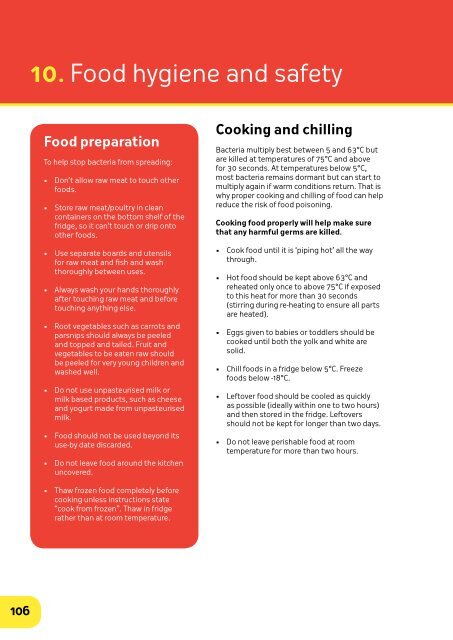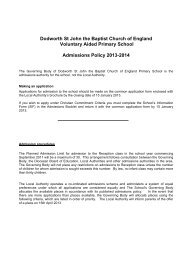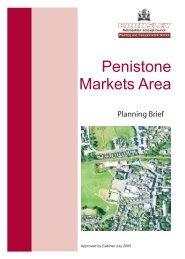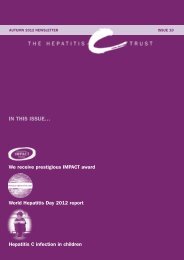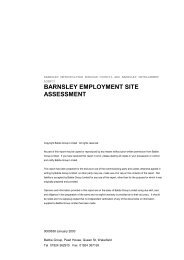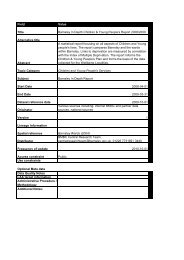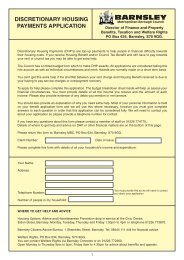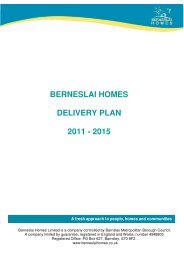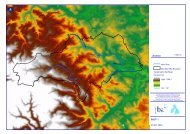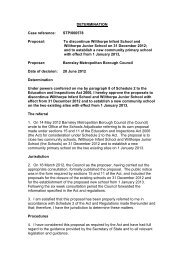Food and Nutrition Guidelines - Barnsley Council Online
Food and Nutrition Guidelines - Barnsley Council Online
Food and Nutrition Guidelines - Barnsley Council Online
You also want an ePaper? Increase the reach of your titles
YUMPU automatically turns print PDFs into web optimized ePapers that Google loves.
10. <strong>Food</strong> hygiene <strong>and</strong> safety<br />
<strong>Food</strong> preparation<br />
To help stop bacteria from spreading:<br />
• Don’t allow raw meat to touch other<br />
foods.<br />
• Store raw meat/poultry in clean<br />
containers on the bottom shelf of the<br />
fridge, so it can’t touch or drip onto<br />
other foods.<br />
• Use separate boards <strong>and</strong> utensils<br />
for raw meat <strong>and</strong> fish <strong>and</strong> wash<br />
thoroughly between uses.<br />
• Always wash your h<strong>and</strong>s thoroughly<br />
after touching raw meat <strong>and</strong> before<br />
touching anything else.<br />
• Root vegetables such as carrots <strong>and</strong><br />
parsnips should always be peeled<br />
<strong>and</strong> topped <strong>and</strong> tailed. Fruit <strong>and</strong><br />
vegetables to be eaten raw should<br />
be peeled for very young children <strong>and</strong><br />
washed well.<br />
• Do not use unpasteurised milk or<br />
milk based products, such as cheese<br />
<strong>and</strong> yogurt made from unpasteurised<br />
milk.<br />
• <strong>Food</strong> should not be used beyond its<br />
use-by date discarded.<br />
• Do not leave food around the kitchen<br />
uncovered.<br />
Cooking <strong>and</strong> chilling<br />
Bacteria multiply best between 5 <strong>and</strong> 63°C but<br />
are killed at temperatures of 75°C <strong>and</strong> above<br />
for 30 seconds. At temperatures below 5°C,<br />
most bacteria remains dormant but can start to<br />
multiply again if warm conditions return. That is<br />
why proper cooking <strong>and</strong> chilling of food can help<br />
reduce the risk of food poisoning.<br />
Cooking food properly will help make sure<br />
that any harmful germs are killed.<br />
• Cook food until it is ‘piping hot’ all the way<br />
through.<br />
• Hot food should be kept above 63°C <strong>and</strong><br />
reheated only once to above 75°C if exposed<br />
to this heat for more than 30 seconds<br />
(stirring during re-heating to ensure all parts<br />
are heated).<br />
• Eggs given to babies or toddlers should be<br />
cooked until both the yolk <strong>and</strong> white are<br />
solid.<br />
• Chill foods in a fridge below 5°C. Freeze<br />
foods below -18°C.<br />
• Leftover food should be cooled as quickly<br />
as possible (ideally within one to two hours)<br />
<strong>and</strong> then stored in the fridge. Leftovers<br />
should not be kept for longer than two days.<br />
• Do not leave perishable food at room<br />
temperature for more than two hours.<br />
• Thaw frozen food completely before<br />
cooking unless instructions state<br />
“cook from frozen”. Thaw in fridge<br />
rather than at room temperature.<br />
106


